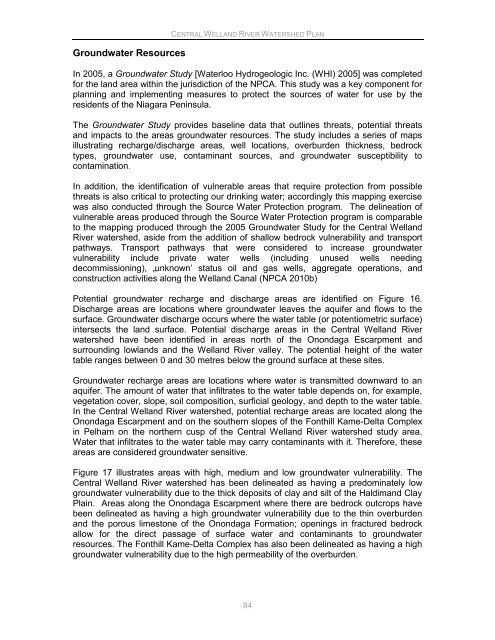Central Welland River Watershed Plan - Niagara Peninsula ...
Central Welland River Watershed Plan - Niagara Peninsula ...
Central Welland River Watershed Plan - Niagara Peninsula ...
- No tags were found...
You also want an ePaper? Increase the reach of your titles
YUMPU automatically turns print PDFs into web optimized ePapers that Google loves.
Groundwater ResourcesCENTRAL WELLAND RIVER WATERSHED PLANIn 2005, a Groundwater Study [Waterloo Hydrogeologic Inc. (WHI) 2005] was completedfor the land area within the jurisdiction of the NPCA. This study was a key component forplanning and implementing measures to protect the sources of water for use by theresidents of the <strong>Niagara</strong> <strong>Peninsula</strong>.The Groundwater Study provides baseline data that outlines threats, potential threatsand impacts to the areas groundwater resources. The study includes a series of mapsillustrating recharge/discharge areas, well locations, overburden thickness, bedrocktypes, groundwater use, contaminant sources, and groundwater susceptibility tocontamination.In addition, the identification of vulnerable areas that require protection from possiblethreats is also critical to protecting our drinking water; accordingly this mapping exercisewas also conducted through the Source Water Protection program. The delineation ofvulnerable areas produced through the Source Water Protection program is comparableto the mapping produced through the 2005 Groundwater Study for the <strong>Central</strong> <strong>Welland</strong><strong>River</strong> watershed, aside from the addition of shallow bedrock vulnerability and transportpathways. Transport pathways that were considered to increase groundwatervulnerability include private water wells (including unused wells needingdecommissioning), „unknown‟ status oil and gas wells, aggregate operations, andconstruction activities along the <strong>Welland</strong> Canal (NPCA 2010b)Potential groundwater recharge and discharge areas are identified on Figure 16.Discharge areas are locations where groundwater leaves the aquifer and flows to thesurface. Groundwater discharge occurs where the water table (or potentiometric surface)intersects the land surface. Potential discharge areas in the <strong>Central</strong> <strong>Welland</strong> <strong>River</strong>watershed have been identified in areas north of the Onondaga Escarpment andsurrounding lowlands and the <strong>Welland</strong> <strong>River</strong> valley. The potential height of the watertable ranges between 0 and 30 metres below the ground surface at these sites.Groundwater recharge areas are locations where water is transmitted downward to anaquifer. The amount of water that infiltrates to the water table depends on, for example,vegetation cover, slope, soil composition, surficial geology, and depth to the water table.In the <strong>Central</strong> <strong>Welland</strong> <strong>River</strong> watershed, potential recharge areas are located along theOnondaga Escarpment and on the southern slopes of the Fonthill Kame-Delta Complexin Pelham on the northern cusp of the <strong>Central</strong> <strong>Welland</strong> <strong>River</strong> watershed study area.Water that infiltrates to the water table may carry contaminants with it. Therefore, theseareas are considered groundwater sensitive.Figure 17 illustrates areas with high, medium and low groundwater vulnerability. The<strong>Central</strong> <strong>Welland</strong> <strong>River</strong> watershed has been delineated as having a predominately lowgroundwater vulnerability due to the thick deposits of clay and silt of the Haldimand ClayPlain. Areas along the Onondaga Escarpment where there are bedrock outcrops havebeen delineated as having a high groundwater vulnerability due to the thin overburdenand the porous limestone of the Onondaga Formation; openings in fractured bedrockallow for the direct passage of surface water and contaminants to groundwaterresources. The Fonthill Kame-Delta Complex has also been delineated as having a highgroundwater vulnerability due to the high permeability of the overburden.84
















